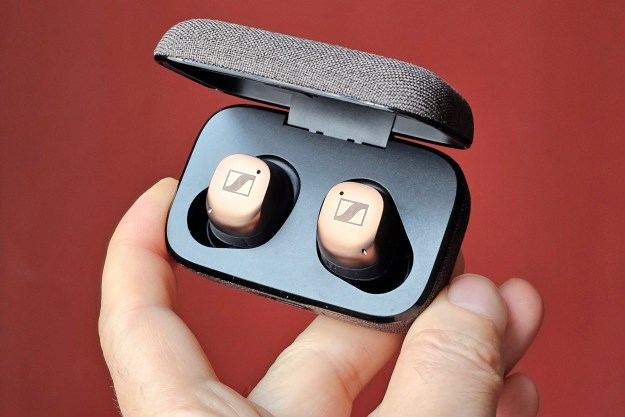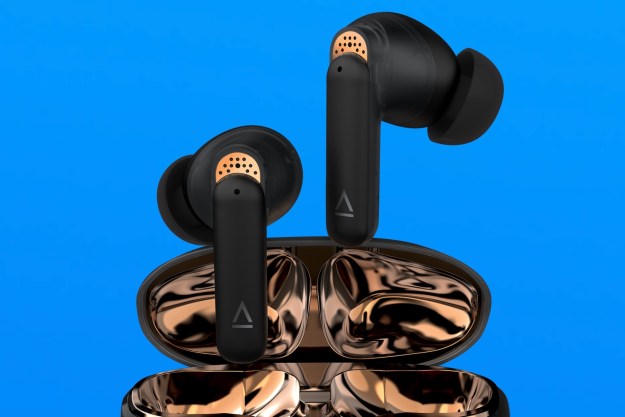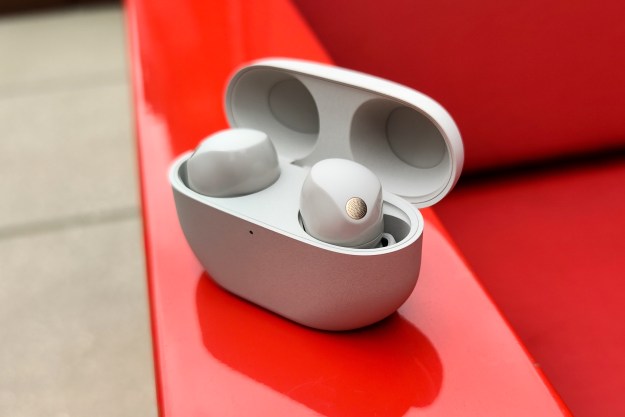
- Excellent comfort and fit
- Great sound quality
- Much improved noise cancellation
- Bluetooth Multipoint
- No side-tone for calls
- Limited phone support for aptX Lossless
Sennheiser has long been a favorite of the audiophile community and is a brand most associated with outstanding headphone audio quality. So perhaps it shouldn’t be surprising that the latest generation of the company’s wireless earbuds — the Momentum True Wireless 4 — have casually sidestepped the whole head-tracking spatial audio trend. While spatial audio might have a growing audience (in no small part due to Apple’s fiery promotional efforts), audio purists remain more interested in good ol’ stereo and how they can get higher-quality sound over a Bluetooth connection.
Knowing that, Sennheiser’s formula for the $300 Momentum True Wireless 4 is simple: improve everything and get ready for what’s next.
After an all-too-brief chance to try these earbuds, I think it’s a winning formula, indeed.
What’s changed?

For brevity, I’ll refer to the Sennheiser Momentum True Wireless 4 (and their predecessors, the Momentum True Wireless 3) as the MTW4 and MTW3, respectively. Here’s what Sennheiser has added — and perhaps why the new model costs $20 more.
- Battery life is now 7.5 hours per charge with 30 hours total versus 7/28, and a new battery management system promises a longer overall operating life
- Bluetooth Multipoint is now supported out of the box. (It was added to the MTW3 with a firmware update)
- Class 1 Bluetooth 5.4 with LE Audio and Auracast support coming via a firmware update
- Qualcomm’s Snapdragon Sound platform, along with its signature feature, lossless audio over Bluetooth, is available for Android phones that also support Snapdragon Sound
- Active noise cancellation (ANC) and transparency modes have been improved
- A new AI voice processing algorithm should help with call quality
- Sennheiser’s app has a new sound personalization feature
- A new IP54 rating adds dust resistance to the existing water resistance of the earbuds
What hasn’t changed?

All the improvements listed above are largely software and chipset-led changes. The earbud drivers — arguably one of the biggest factors in sound quality — remain the same 7mm TrueResponse dynamic units Sennheiser has been using for several years.
On the outside, the MTW4 are identical to their predecessors, save for three color choices. The white and silver models now have metallic-look endcaps, and a slick new copper-black option replaces the graphite variant.
The earbuds’ shape has been preserved. So, if the MTW3 provided you with a good fit, you can expect the same from the MTW4. For me, it’s an excellent match for my ears. The MTW3 changed my opinion of Sennheiser’s earbuds from a comfort and fit point of view, so I’m delighted to see nothing’s been altered on that front.

The same goes for the charging case. It’s still wrapped in a soft but durable fabric, has excellent lid and hinge operation, and still supports wireless and USB-C wired charging. The only negative is that it’s still bulky, boxy, and nearly twice as thick as the Apple AirPods Pro.
Sennheiser once again includes a charging cable, four sizes of silicone eartips, and three sizes of earfin stability bands. A fit test in the Sennheiser Smart Control app helps ensure the best seal possible.
Touch controls done right

I maintain that physical controls are preferable to touch controls. They have a tactile quality that can’t be beaten, and you can usually use them with gloved hands. Still, Sennheiser’s touch controls are some of the best in the business.
The entire outer shell of the earbuds is touch-sensitive, and you get an audible confirmation for each successfully recognized tap. They’re also extremely customizable within the Smart Control app. So, if you don’t like the default gestures and functions, they can be changed.
Augmenting the usual play/pause function are wear sensors on the earbuds that can auto-pause and resume your music when you remove one or both earbuds. Auto-pause takes a second to kick in, while the resume function happens instantly.
Better Bluetooth

Bluetooth Multipoint is a must these days as most of us spend ever-increasing amounts of time on multiple devices, and the MTW4 do it well. You can connect to any two devices simultaneously, and switching between them is seamless. The Smart Control app lets you see all of the devices you’ve previously paired with, which makes picking those two connections dead simple.
For the MTW4, Sennheiser has upped the Bluetooth version to 5.4 and says it will add support for LE Audio and Auracast via a firmware update. Both features are worth having, but both are very much forward-looking. LE Audio — via the new LC3 codec — promises lower latency, lower energy, and higher-quality audio compared to both the AAC and SBC codecs. Not many phones support it yet, but you’ll be ready when they do.
Auracast, in my opinion, is more interesting. It lets folks share their Bluetooth audio with an unlimited number of other listeners, and it creates the first standard for Bluetooth broadcasting in public spaces like airports or conferences. Auracast went from theory to practice at CES 2024, but it may still be a year or two before you start to see it proliferate. Still, you’ll be ready when it does.
My one note on the MTW4’s Bluetooth performance is that it seems to have a shorter wireless range than other earbuds in its class. As I moved between the floors of my house, I couldn’t get very far without the connection from my iPhone breaking up. The Apple AirPods Pro, by contrast, can roam anywhere without issue. At one point, when I was at the gym, the MTW4 lost their connection to the phone for almost 40 seconds before reconnecting. I can see this being a firmware issue. Increasingly, I’ve been receiving review devices that are still being actively improved. I’ll update this review if things change.
Go lossless — if you can

There are still precious few Android phones that support aptX Lossless through Qualcomm’s Snapdragon Sound platform. In fact, I had to borrow a Motorola ThinkPhone because it’s one of the few handsets that do. But if you own one of the phones or plan to buy one, the Sennheiser MTW4 can deliver bit-perfect, CD-quality audio. Or, at least, that’s the claim.
I have no way to verify it, and I suspect nothing less than root-level access to the earbuds’ onboard digital-to-analog converter (DAC) would let you do so. For me, purely based on my ability to discern differences in quality, the jury’s still out on whether aptX Lossless is better than aptX Adaptive, a lossy yet hi-res audio codec that is supported on a much wider range of phones.
One thing’s for certain: both are markedly better than AAC (the default codec on iPhones) or SBC (the default codec for all Bluetooth audio).
Why should you even care about lossless? Honestly, if you’re a Spotify listener, it doesn’t matter much since that service doesn’t (yet) let you stream lossless audio.
But if you’ve chosen a streaming music service like Apple Music, Amazon Music, Tidal, or Qobuz because you want lossless, CD-quality audio (at a minimum), aptX Lossless is your best bet for preserving that extra sound quality.
Codec control
What’s unusual about Sennheiser’s approach to these codecs is that it gives you some say over which one you want to use. Usually, when a set of earbuds connects to a phone, the two devices swap info regarding which codecs they have in common and then default to the one with the highest quality.
Using the Smart Control app, however, you can choose between four audio resolution settings: standard, low latency, high-resolution, and lossless — each with its own specific flavor of aptX.
On an iPhone, these settings are essentially ignored. Regardless of which one you pick, you’ll always use the AAC codec because that’s all Apple supports.
But even on Android phones, these options represent a desired state — not a guaranteed state.
For instance, if your phone supports aptX Lossless and you choose the lossless setting, the MTW4 will attempt to connect using aptX Lossless. If your phone supports aptX Adaptive but not aptX Lossless, you’ll get Adaptive at the highest sampling rate your device can manage. Finally, if your phone only works with the aptX codecs that ship with Android (aptX/aptX HD), you’ll get aptX.
The caveat with any Bluetooth codec is that it’s all dependent on the quality of your Bluetooth link. A poor Bluetooth connection will force a scaling back of audio quality, irrespective of which setting you select in the app.
Sounds like Sennheiser

Popping the MTW4 straight out of the box into your ears provides the kind of clear and balanced sound signature that Sennheiser is known for. Bass response is punchy without being overwhelming, and the mids have plenty of detail.
However, as soon as I swapped them for the Sony WF-1000XM5, the MTW4 felt pale and somewhat two-dimensional by comparison. That’s when I tried the new My Sound personalization feature in the Smart Control app. What a difference.
The My Sound process steps you through two balancing exercises, where you’re asked to find the mix of strings and bass that sounds right to you. The third step introduces drums to the mix, and in the last step, you’re given a square grid-like space and a moveable blue disc to fine-tune the EQ.
Once I’d found my preferred setting, the MTW4 came alive.
Definitely take time to customize the sound.
As I get older, I find I’m not as sensitive to higher frequencies. Normally I’d spend time messing around with the included five-band equalizer to get the 6kHz boost that helps with this, but the My Sound personalization accomplished the same thing and it was fun using its fine-tune step.
The result was still less immersive than the XM5 and the Bose QuietComfort Ultra Earbuds, both of which have wider soundstages. That’s less of a criticism than it sounds — not everyone likes the way Sony and Bose process audio. Some folks find those earbuds to be boosted in all the wrong ways. Sennheiser’s more conservative approach will be appreciated by these listeners.
Sennheiser’s best noise cancellation and transparency

Bose, Sony, and Apple are locked in a three-way battle for the supremacy of silence, with each new generation of wireless products upping the ante yet again. The reason they’re the companies to beat is that each has developed proprietary ANC technology.
This puts Sennheiser at a disadvantage, and yet the MTW4 are nonetheless a significant improvement over the third-gen earbuds in both ANC and transparency. And unless you demand nothing less than the best, I think they provide more than enough ability to quiet annoying background noise.
Perhaps more impressive is the speed with which they can switch from ANC to transparency — a single tap on the left earbud (by default), and you’re in a whole new world.
And I’m very appreciative of the option that lets you pause music when you switch to transparency. It should be available on every ANC-capable product.
My only note on the MTW4 is that the ANC mode introduces a slight but noticeable hiss. It gets erased the moment you start listening to music, but if you’re hoping to use the feature on its own, you may find it distracting.
Great calls for your contacts

Another area that sees a meaningful improvement over the MTW3 is call quality. I wasn’t especially impressed by the third-gen’s ability to manage background noise. It tended to produce bad bouts of wobble and compression. The MTW4 are far more deft at extracting your voice from these other sounds. While not perfect, they’re never going to leave your callers constantly demanding that you repeat yourself.
However, I’m not happy that Sennheiser continues to treat side-tone (hearing your voice on calls) as unnecessary. For me, the thing that can make video and voice calls exhausting is my inability to hear my voice naturally. It’s why I much prefer using open-ear earbuds for these tasks.
It’s hard to find another set of wireless earbuds that do not offer side-tone, and yet it remains absent on the MTW4. Sennheiser, if you’re listening, please fix this.
A better battery
Sennheiser says you’ll now get up to 7.5 hours per charge with 30 hours total when you include the charging case. That’s assuming 50% volume. Using ANC only knocks these numbers down to seven and 28, respectively. You can get an extra hour of playtime with just eight minutes of charging. That’s probably more than enough for most uses.
I’ll be honest: three days of testing isn’t enough time to get a sense of whether Sennheiser’s claims for the MTW4’s battery life are accurate. However, the time I did log with these earbuds reduced their battery percentage readouts in the Sennheiser app proportionally to those claims, so consider this a provisional pass.
The Sennheiser Momentum True Wireless 4 may lack some of the bells and whistles found on other high-end earbuds, especially when it comes to spatial audio. But when it comes to the core features that matter most on a set of $300 earbuds — comfort, sound quality, noise cancellation, transparency, call quality, and battery life — they can more than hold their own.
Editors' Recommendations
- Nothing’s new earbuds upstage Apple, Google, and Amazon by embedding ChatGPT
- Cambridge Audio’s first AirPods Pro competitor has lossless audio, massive battery life
- Best wireless speakers for 2024: Sonos, JBL, KEF, and more
- Sennheiser’s new sports earbuds send heart rate, temperature to popular fitness apps
- Sennheiser Momentum True Wireless 4 debut with lossless audio, but skip the spatial trend











